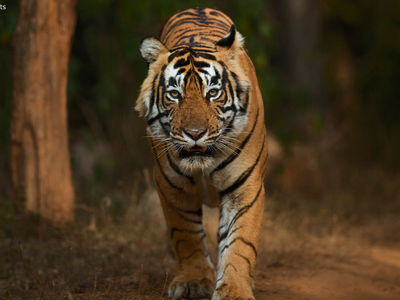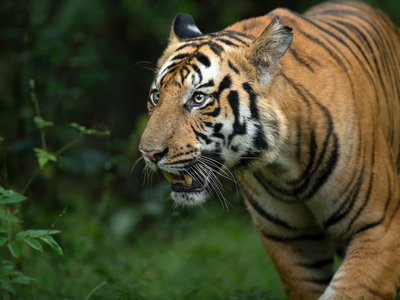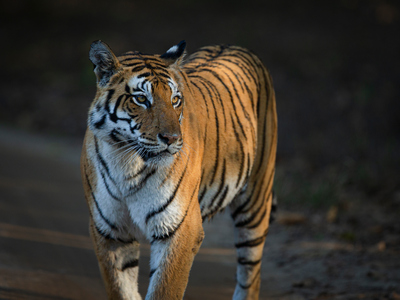Ranthambore National Park – A Traveller’s Guide 2024
Ranthambore National Park spans 1334 square kilometers, encompassing 400 square kilometers of rocky hill crests and open valleys between the Aravalli and Vindhya ranges. Dotted with water pools and fruit trees, the park derives its name from the ancient Ranthambore Fort, standing tall above the forest. This rich landscape witnessed historical events, facing invasions from the Khilji army in 1301 AD and the Mughal dynasty in 1569, later transforming into the private hunting grounds for the Maharaja of Amer.
In 1973, it earned the designation of a Project Tiger reserve in India. On November 1, 1980, Ranthambore National Park officially became a national park, while the adjoining forests were named Sawai Man Singh Wildlife Sanctuary & Kailadevi Sanctuary in 194 and subsequently integrated into the Tiger reserve zone in 1991.
Highlight: Historical Roots and Tiger Sanctuary Designation
Ranthambore National Park is not just home to tigers; it shelters smaller predators like leopards, hyenas, jackals, and jungle cats. Caracals have also been documented. With around 300 bird species, the park hosts a diverse range of wildlife, including sambar, cheetal, chinkara, nilgai, and langur.
Tigers At Ranthambore National Park
Famed for its tiger sightings, Ranthambore National Park has witnessed a surge in tiger activity during daylight, owing to robust conservation efforts in the past decade. This sanctuary has been home to iconic Tigers like Ghengis Khan, Noor, Machli, T17, T24, and the current resident, T19.
Machli, celebrated as the world’s most photographed tigress, has also graced numerous documentaries. Notably, Ranthambore’s unique tiger behaviors were observed and captured, showcasing a large male tiger openly hunting at the edge of lakes, chasing down its prey—an unforgettable sight.
One of the park’s most extraordinary moments captured during a Ranthambore Tiger Safari involves a tiger engaging in a fierce battle with a crocodile over a Sambhar deer carcass, ultimately seizing possession in broad daylight. Witnessing these legendary tigers and their remarkable behaviors makes Ranthambore an unparalleled destination for wildlife enthusiasts.
Reaching Ranthambore National Park
Air
The nearest airport is Jaipur International Airport, which is located around 180 km from Ranthambore National Park. The airport has daily flights from major cities in the country like New Delhi, Mumbai, and Kolkata.
Train
The nearest station is Sawai Madhopur Railway Junction, which is located 11 km from the Ranthambore. There are weekly trains from New Delhi to Sawai Madhopur.
Road
Ranthambore National Park is connected with the State Highway, which is connected with the major cities like Jaipur (180 Km, 3 hours’ drive) Agra and many others.
Popular Ranthambore Tiger Safari Tours

9 Nights 10 Days
Top Rated Safari Tour
Kanha, Bandhavgarh and Pench Tiger Safari Tour
Stay vigilant and attentive to discover the most authentic tiger safari excursion, a thrilling experience reminiscent of Rudyard Kipling’s renowned novel, “The Jungle Book.”

9 Nights 10 Days
Top Rated Safari Tour
JUST TIGERS SAFARI TOUR IN
INDIA
Stay vigilant and attentive to discover the most authentic tiger safari excursion, a thrilling experience reminiscent of Rudyard Kipling’s renowned novel, “The Jungle Book.”

9 Nights 10 Days
Top Rated Safari Tour
LUXURY TIGER SAFARI IN CENTRAL INDIA
Stay vigilant and attentive to discover the most authentic tiger safari excursion, a thrilling experience reminiscent of Rudyard Kipling’s renowned novel, “The Jungle Book.”
Best Season For Tiger Sightings At Ranthambore National Park
Winter: The winter phase spans from November through February. Dense fog is prevalent in early mornings and late nights during the peak winter period. The prime time to explore Ranthambore National Park sees an influx of tourists from early November to mid-December and again from mid-January to mid-April.
Summer: From late March to late June, the summer season prevails, witnessing daytime temperatures soaring to 40 °C while nighttime temperatures hover around 30 °C. In May and June, temperatures can surpass 45 degrees Celsius, creating intensely hot days. Dry winds and scorching sun characterize this period. Tigers and other large predators seek refuge in valleys, dense forest areas, or near water bodies.
Monsoon: Following the summer, the monsoon arrives, spanning July to September. Zones 6-10 in Ranthambore National Park become accessible, while zones 1-5 remain off-limits due to waterlogged tracks and mud caused by rainfall.
Where To Stay During Your Ranthambore Tiger Safari
Zoning In: The Ranthambore National Park Experience
Zone 1: Encounter tigers like Sultan (T-72), Noor (T-39) with Two Cubs, Ustad (T-24) amid key locations such as Tuti ka Nalla, Amreshwar Dang, Sultanpur, Peela Pani, Gada Dub.
Zone 2: Witness the majestic Gayatri (T-22), Ustad (T-24), Krishna (T-19) with Three Cubs, and others in Zone 2 with prominent spots like Jogi Mahal, Phuta Kot, Phuta Bandha, Lahpur Tiraha, Nal Ghati.
Zone 3: Marvel at Star Male (T-28), Krishna (T-19) with her three Cubs in Zone 3, featuring Jogi Mahal, Padam Talab, High Point, Raj Bagh, Mandook.
Zone 4: Explore Zone 4 to spot tigers like Machli (T-16), Dollar (T-25), Star (T-28), Romeo (T-6), Mr. Bond (T-47), Laila (T-41) in Singh Dwar, Malik Talab, Lakkad Da, Adidaant, Lambi, Tamakhan.
Zone 5: Encounter tigers including Romeo (T-6), Sunehari (T-17) with her two Cubs, Dollar (T-25), Bahadur (T-3), Laila (T-41) with her one cub in Singh Dwar, Anatpur, Jokha, Dhakda, Kachida, Baghda, Bakola.
Zone 6: Spot Ustad (T-24), Kumbha (T-34), Sultan (T-72), Noor (T-39) with Two Cubs in Kala Pani, Saran Ka Pattha, Patwa Ki Baori, Khabli, Soleshwar, and more in Zone 6.
Zone 7: Witness Ladli (T-8) with Two Cubs, Kumbha (T-34) in Chidikho, Jamoda, Kushalipura, Rajbagh Naka within Zone 7.
Zone 8: Observe Ladli (T-8) with Two Cubs, Kumbha (T-34) in Balas, Kherai, Kali, Neemli Dang, Bhat, Mahakho within Zone 8.
Zone 9: Spot Fateh (T-42), T-59 (occasionally) along the Banks of Chakal River in Zone 9.
Zone 10: Encounter T-42 (Fateh, Male Tiger), T-13 (Old Sultanpur Female) with her three 6-month-old Cubs in Aantri, Kushalipur, Bodal, Halonda, Banskhori within Zone 10.
Types Of Safaris At Ranthambore National Park
Ranthambore National Park distinguishes itself by numbering its zones instead of naming them. Initially boasting 5 zones, the park expanded to 10 to cater to the growing interest of wildlife enthusiasts. Each of these zones teems with distinctive flora and fauna, offering a diverse safari experience. A total of 144 jeeps and canters are permitted across all 10 zones for each morning and afternoon tiger safari shift.
Both vehicle types traverse the same designated tiger safari tracks within their allocated zones, with no interchange allowed. The safari vehicles have the freedom to explore the network of routes in their designated zone. The safari’s commencement aligns with sunrise and sunset, lasting nearly 3.5 hours.
In full-day and half-day safaris, visitors can explore different zones within their allotted time. Full-day and half-day tiger safaris in Ranthambore National Park begin at sunrise in zones 1-5, returning by 12:30 PM. After lunch, full-day safari vehicles can venture into zones 6-10, either continuously or resuming after 2:30 PM, exploring zones 1-5 again in search of tigers and returning before sunset.
Reasons To Visit Ranthambore National Park
Ranthambore National Park remains a pivotal force in wildlife preservation, with certain tigers achieving star status through TV shows and documentaries. This region’s landscape, characterized by deep gorges, grassy slopes, rugged hills, ravines, and expansive lakes, captivates photographers. Here are the top 5 reasons to venture into Ranthambore:
Golden Triangle Synergy: Experience the park seamlessly with a Golden Triangle tour, encompassing Agra, Jaipur, and New Delhi, maximizing tiger sightings.
Historic Panorama: Ranthambore Fort offers not just a historical narrative but also panoramic forest views, adding depth to your visit.
Magical Wilderness: The park seamlessly blends natural beauty with a historical past. Crumbling ruins, from chhatris to cupolas, evoke the ethereal quality of this wilderness.
Lakeside Serenity: Three large lakes—Padam Talao, Raj Bagh Talao, and Milak Talao—enhance the picturesque setting, inhabited by crocodiles.
Avian Paradise: Boasting around 300 bird species, Ranthambore is a haven for bird enthusiasts. The park and its surroundings create a paradise for avid bird watchers.
Trip To Ranthambore National Park: Faqs
Ranthambore National Park is renowned for its thriving population of Bengal tigers, offering visitors a high probability of tiger sightings. The park’s diverse ecosystem, including lakes, grasslands, and dense forests, provides an ideal habitat for these majestic creatures. Additionally, the park’s historical significance, with the ancient Ranthambore Fort within its boundaries, adds to its appeal.
Corbett National Park, located in the foothills of the Himalayas, offers a unique tiger safari experience characterized by its varied landscapes, including riverine belts, grasslands, and hills. Unlike Ranthambore, Corbett is not only known for tigers but also for its rich biodiversity, including diverse bird species. The park’s landscape and the chance to spot tigers in their natural habitat make Corbett a distinct and rewarding destination for wildlife enthusiasts.
The best time to visit Ranthambore National Park for a tiger safari is from October to April. During this period, the weather is relatively pleasant, and the vegetation is not as dense, making it easier to spot wildlife, including tigers. The park remains closed during the monsoon season (July to September) to facilitate wildlife conservation efforts and ensure visitor safety.
Yes, Corbett National Park actively participates in tiger conservation initiatives. The park is part of the Project Tiger initiative, a national program dedicated to the conservation of the Bengal tiger. Conservation efforts in Corbett include habitat preservation, anti-poaching measures, and community involvement. The park plays a crucial role in maintaining a sustainable ecosystem and ensuring the long-term survival of the tiger population in the region.
Enquire Now
Please fill the form below and our team will get back to you within 24 hours with a perfect tiger safari tour package.

